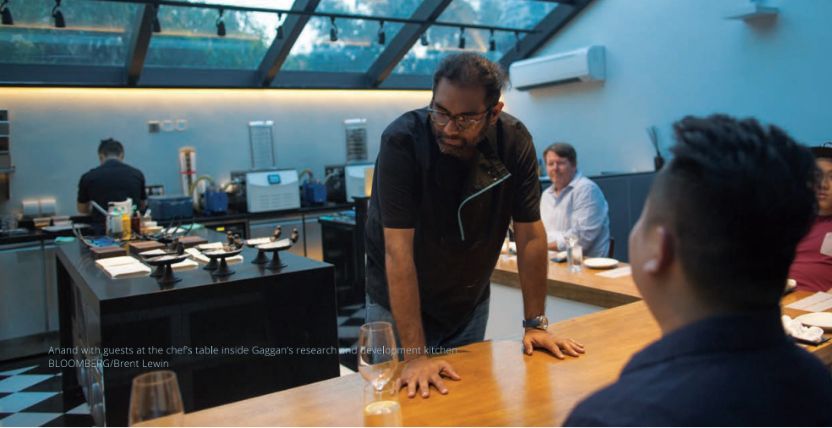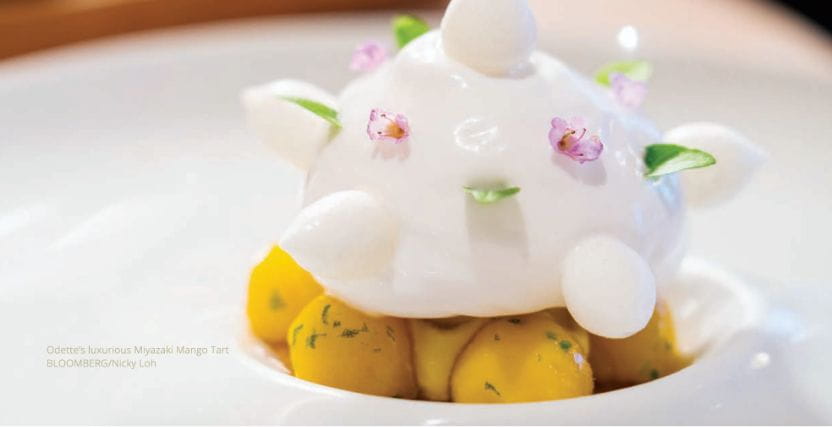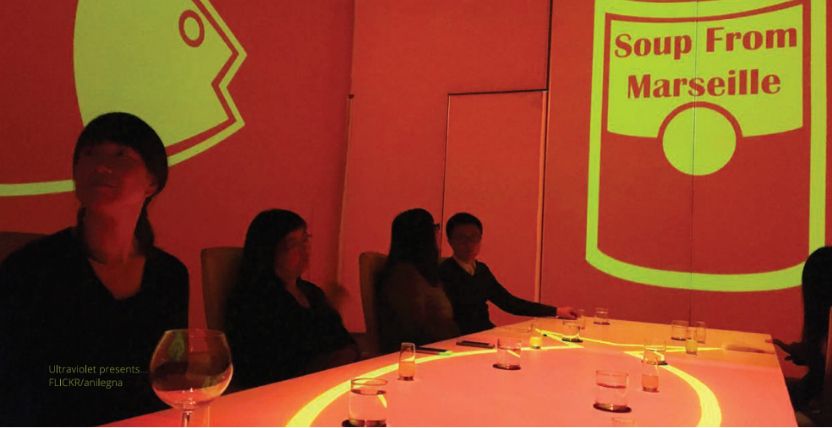At the latest edition of the Worldʼs 50 Best Restaurants awards in Singapore, all five of the worldʼs best chefs Forbes interviewed named Asian cities as the most fascinating places to travel to for food—not only for the local cuisine but also for fine dining.1
Not surprisingly, seven out of William Reed Business Mediaʼs list of Worldʻs 50 Best Restaurants are in Asia.2 Here are some of them and their owners, a new generation of chefs who are taking these restaurants into very interesting territories. Consider this a whiff of the unique subtleties and complexities of fusion fine dining found only in Asia.

Repeatedly listed on the Worldʼs Best Restaurant year after year is Gaggan by Kolkatta-born Michelin-star chef Gaggan Anand. Using molecular gastronomy, Anand has reinvented traditional cuisine like no one else has.
He also serves them like no other restaurant does.
Anand is all about the authenticity of traditional Indian flavours and tastes, on an obsessive level. He heightens this authentic experience with a menu with just emoji—no words—and very limited cutlery. Out of the 25 courses served, 23 are eaten by hand as Indian food traditionally is. Only after you complete your meal, will you be served with a proper menu with information about the dishes that youʼve just experienced.
One of his signature dishes, the coin-sized eggplant cookie, would likely be the most memorable. Fresh eggplant is charred, skinned, cooled, freeze-dried, ground and molded into a powdered compress with curry oil and Indian spices. He then folds them over a layer of onion chutney jam. This complex dish takes four days to make. The experience may take much, much longer to forget.3

Few top chefs in the world can afford to be this playful when it comes to food philosophy.
But Denʼs owner-chef Zaiyu Hasegawa has broken all the kaiseki rules.
He presents a personal take on traditional Japanese home-cooking. While prime ingredients are always from the ocean, pasture and forest, he draws on diverse experiences of his own to reinterpret them in curious ways.
Start with his signature foie gras monaka or wafer sandwich, dig into the 20-plus vegetable Den garden salad, and eat out of a box of Dentucky Fried Chicken—probably the best chicken wings youʼll ever taste. If things get any stranger, you can rely on the donabe-gohan, the staple claypot-cooked rice with wagyu beef or seafood.4 As his crew prepares the meals, you should prepare to be surprised.
Named after the chef-ownerʼs grandmother, Odette is a personal project by rising star Julien Royer after taking his previous restaurant Jaan to No.11 in Asiaʼs 50 Best Restaurants 2015. This year, Royerʼs Odette is Asiaʼs No.1.
Odette is Royerʼs modern-take on French cuisine with Asian influences, sourcing ingredients from a select list of artisanal producers.
The approach is ultra-refined in terms of preparation and presentation. The art is highly evident in the signature dishes. They include the rosemary-smoked organic egg and Royerʼs morels with veal sweetbreads and fresh asparagus. Suffice to say, only a handful of masters like Royer can bring the combination of sea urchin, langoustine tartare, Granny Smith apple and caviar to stunning effect in a Hokkaido Uni.5

Despite the saturated streets of top-notch Cantonese cuisine in Hong Kong Central, The Chairman has proven yet again to be the cityʼs best kitchen for the last decade. They say it has remained untouched through its simple culinary philosophy—quality, local and seasonal produce over fancy ingredients.
Here, the best way to order is to leave it to The Chairmanʼs trusted restaurant captains. They normally recommend a bespoke menu based on the season and past guestsʼ remarks. The owner Danny Yip, however, will almost always suggest the flower crab for first-time customers. With business this healthy, he must have good reasons for doing so. For one, this umami-rich steamed flower crab, served in a shallow broth of nutty, aged Shaoxing wine, with chicken oil and slippery flat rice noodles, is a signature dish many other Hong Kong establishments have tried to replicate and gave up.6 Itʼs no wonder that The Chairman is also No.11 on the Asiaʼs 50 Best Restaurant list.7
Described as ʻthe ultimate in immersive, multi-sensory diningʼ by the Worldʼs 50 Best Restaurants, the Ultraviolet experience is wholly avantgarde and satisfyingly surreal.8
Ultraviolet is not a place, but a journey of the senses associated with food. Literally.
It starts with the familiar—a venue at the city centre, cocktails, and a quick bite with other diners. Then something unexpected turns up—a van. It shuttles the entire company of diners to a nondescript building in the outskirts of Shanghai. On arrival, a large door swings open and youʼre led into a bare room with a single long dining table. One of the seats is illuminated with your name. The meal begins, accompanied by images, graphics and sounds projected in sync with the flavour and finery of each course.
Immaculately-choreographed waiters and waitresses present you with a meal of 20-odd courses in four acts with intermissions in between. Standout dishes include the DIY BLT sandwich and the Foie Gras Canʼt Quit, a crisp fruit-skin cigar stub packed with foie gras and served in an ashtray of black cabbage ʻashʼ,8 while the rest of the experience could well be just the product of your own imagination.

Obvious question, but one that youʼll never be asked at any of these restaurantsʼ receptions. Gaggan, for instance, manages up to 500 booking requests a day3 and would expect you to have a table reservation months in advance. Some places are fullybooked up to a year. The price of a 20 - course meal at this level too can be daunting.
Then again, thereʼs nothing like spending on a new experience and great food. Gastronomical satisfaction is at the heart of human happiness and now, adventure. With so many up-and-coming chefs invested in passion projects and experimenting with exciting culinary trends right here in Asia, itʼs just impossible to ignore. And too close by to turn down.
As the worldʼs culinary landscape changes, so do the reasons we travel. The next time you fly out of KLIA, it could be more than a business trip or golf getaway; it could well be a divine dining experience.

Complete your luxurious experiences abroad with Premier access. Your RHB Relationship Manager recommends the RHB Premier Visa Infinite Credit Card, your passport to world-class travel privileges. With the Premier in your pocket you have unlimited access to premium lounges* around the globe, exclusive end-to-end travel concierge and 8x Reward Points for all retail spend including hotels, airlines, duty-free, dining and online shopping. Remember to also bring along your RHB Premier Visa Infinite Debit Card to enjoy an additional 1% Cash Back on all your overseas indulgences.
*Plaza Premium Lounges in Malaysia and other locations around the globe and the region in Abu Dhabi, Hong Kong, London, Singapore, Taipei, Indonesia, Cambodia, the Philippines, and the Maldives. Terms and Conditions at www.rhbgroup.com
Sources : 1 Forbes, The Chefs Behind Five Of The World’s Best Restaurants On Where They Travel For Food, 30 June 2019. 2 The World’s 50 Best Restaurants 2019. 3 Bloomberg, Why the best restaurant in Asia is Shutting Down, 25 May 2017. 4 The Worldʼs 50 Best Restaurants 2019. No.18–Den, Tokyo, Japan. 5 The Worldʼs 50 Best Restaurants 2019. No. 18–Odette, Singapore. 6 The Worldʼs 50 Best Restaurants 2019, No.41–The Chairman, Hong Kong, China. 7 Bloomberg, Asia’s 50 Best Restaurants, 27 March 2019. 8 The Worldʼs 50 Best Restaurants 2019. No.48–Ultraviolet by Paul Pairet, Shanghai, China.